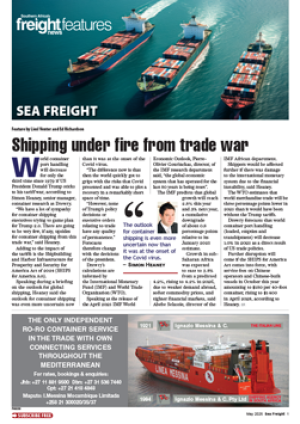Productivity better but still room for improvement RAY SMUTS MARITIME CARRIER Shipping (MACS) has been a regular caller at the Port of Durban’s New Pier facility for a good two decades so South African MD Felix Scheder-Bieschin can be forgiven for becoming a little tetchy when asked to assess a new terminal not even open for business. The final stage of New Pier’s conversion into a full container terminal will commence during mid 2006 by which time the line’s Durban operations will be moved to the brand new ‘City Terminal’ at Point. “I don’t know about efficiency because it has not been tested but the move to City Terminal next year seems to be problematic given environmental issues (a residential area alongside), traffic and rail concerns. Total cargo mix “Although the port has assured us we will be able to work the whole cargo mix, that does not seem to be the case. “I don’t blame the residents because they don’t like noise and dust so we will have to see by next year what sort of cargo that terminal will actually handle. “I do have my doubts that we will be able to keep our total cargo mix in Durban and expect that some of it will have to move to Richards Bay, which does not overly concern us because our ships call there anyway. Both MACS services call at Richards Bay sandwiched between two Durban calls. Hamburg-based MACS operates a fleet of ten vessels on two schedules, the MACS service between South Africa and Europe every ten days and the GAL service between South Africa and the US Gulf every 14-18 days. Referring to the carrier’s operational workings with management and staff at New Pier, Scheder-Bieschin comments: “We can see that, bearing in mind the constraints they are facing, they are trying very hard to make things work.” He recalls that prior to the advent of New Pier a somewhat ‘old-fashioned’ operation was followed, in that vessels first had to move to a discharge berth, unload all cargo, and then proceed to a loading berth. “That obviously was not very productive so New Pier was a step in the right direction in that all was accomplished at the same terminal.” The next big step came in 1995 when the line’s container operation was transferred from the container terminal. This eliminated waiting times at Pier two and generated substantial efficiencies because general cargo could be handled simultaneously with containers. The next change should have been the integration of stevedoring and terminal operation into one entity but, although it is already standard in most ports around the world, this project is still on hold in South Africa. This is mainly due to political reasons around privatisation. Scheder-Bieschin hopes that progress will be made once the National Ports Authority bill, which is dealing with this and other issues, is enacted.
